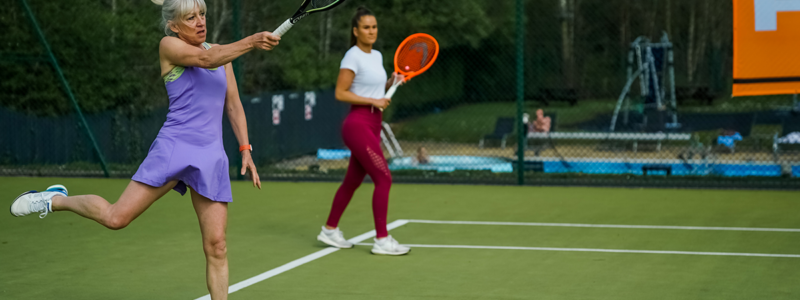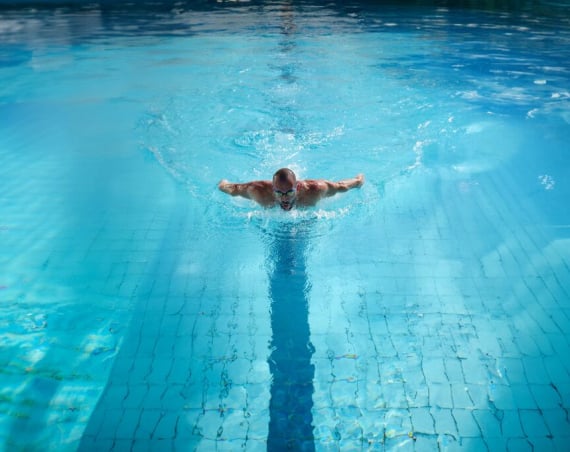Watching professional tennis players, it’s easy to see that this is a game of skill, endurance and power. The best players start their training on the court at a young age – but you don’t have to be a professional or start early in life to play tennis and enjoy all the benefits that it brings.
Here’s what beginners should know about the basics of tennis, as well as the benefits of incorporating it into your usual workout regime.
Benefits of tennis
We all know cardio exercise is important for your overall health, but typical cardio workouts like running and cycling aren’t for everyone. If you’re looking for more of a social workout that incorporates a little competition, tennis might be the perfect option for you. Here are some of the biggest health benefits of playing tennis:
- Improved cardiovascular health: Running up and down the court, jumping for the perfect serve and chasing after the ball is guaranteed to get your heart pumping.
- Increased range of motion: The broad swinging, hitting and reaching movements in tennis work as dynamic stretching motions that help strengthen the joints and make muscles and tendons more robust.
- Improved balance: Using a racquet and consistently transferring your weight as you move around the court trains your body to maintain and/or regain its equilibrium when off balance, which will come in handy on and off the court.
- Enhanced agility: Lots of back and forth, side-to-side, and diagonal movement patterns that require changes of speed and direction train the body and mind to adapt quickly.
- Developed motor control: Tennis can boost your core strength and the ability to stabilise one body part while another body part is moving.
Choosing the right tennis equipment
Tennis racquets
Using the right racquet is essential if you’re at the beginning of your journey to learn how to play tennis. To work on your hand-eye coordination, choose a racquet with a midplus or oversize head, giving you a larger sweetspot and more chance of making a solid connection with the ball. To work on generating more power in your shots, a lighter racquet (230g to 300g) will help you to maintain stability and good technique.
Tennis balls
Pressureless: Designed to achieve more bounce from the rubber structure rather than the air on the inside, these balls are hard-wearing and maintain bounce over time.
Pressurised: Used in professional and amateur tournaments, these balls provide more bounce, speed, and spin when brand new. A pressurised tennis ball is used by all standards of players and is the most commonly used ball by club players.
Sponge, red, orange and green tennis balls: To help children develop their skills, it can be beneficial to progress through using different stages of tennis balls. As progression is made, the balls move more quickly through the air. Starting from soft and slow foam balls, children move onto using red, orange and green balls as they improve to the point at which they can switch to using regular tennis balls.
We recommend that adult beginners use green balls. They are a regular sized ball and are deflated to 75% of a standard pressurised tennis ball. This ball does not bounce as high or go as fast as the pressurised ball and it allows players to have longer rallies and work more easily on their strokes.
Clothing & footwear
It’s important to wear lightweight, breathable clothing that gives you the freedom to make the movements required when playing a game of tennis. The best tennis shoes have a specific tread made for 360-degree movement whilst providing good lateral support and stability. The type of shoe you wear can depend on the surface you are playing on, allowing you to have the right level of grip to move, stop and turn effectively.
Basic tennis technique for beginners
When it comes to tennis technique, fixing bad form can be more difficult than learning the right technique and form in the first place. If you’re a beginner, take some time to practise different ways to grip your racquet, serve and hit the tennis ball. Here are four basic techniques you should look to master:
- Serve: In a basic serve, the player tosses the ball up, shifts their weight to the back foot and reaches above their head to hit the ball, at full stretch, over the net into the diagonally-opposite service box.
- Forehand: This is a groundstroke that takes the racquet across the player’s body with an open palm. The racquet should make contact with the ball before continuing the motion across the body, with the hand and racquet finishing above the opposite shoulder.
- Backhand: Either one-handed or two-handed, a backhand takes the racquet across the body with the back of the hand leading and moving towards the opponent on the follow through, again with the hand(s) and racquet finishing above the opposite shoulder.
- Volley: A shot in which the ball is struck before it bounces. There are a few types of volley but a regular volley is usually accomplished closer to the net with a short backswing. Think more about letting the ball hit the racquet than trying to impart too much power when volleying the ball.
If you’re interested in improving your tennis strokes then practice makes perfect. From picking up the rules of the game, to working on perfecting your technique, our range of indoor and outdoor courts and expert professionals make David Lloyd Clubs the perfect place to learn to play tennis. Check out our Fast Track tennis course for beginners and all the other group tennis classes and one-on-one coaching sessions David Lloyd Clubs has to offer for players of all ages.
Ready to sign up for a tennis lesson? Find a David Lloyd Club near you.
Find a club



